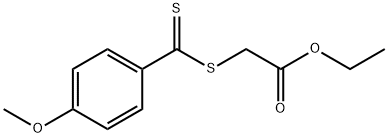Ethyl 2-((4-methoxyphenylcarbonothioyl)thio)acetate

Ethyl 2-((4-methoxyphenylcarbonothioyl)thio)acetate structure
|
Common Name | Ethyl 2-((4-methoxyphenylcarbonothioyl)thio)acetate | ||
|---|---|---|---|---|
| CAS Number | 129841-40-3 | Molecular Weight | 270.37 | |
| Density | N/A | Boiling Point | N/A | |
| Molecular Formula | C12H14O3S2 | Melting Point | 30-35°C | |
| MSDS | Chinese USA | Flash Point | >110℃ | |
|
SPREDs (Sprouty related proteins with EVH1 domain) promote self-renewal and inhibit mesodermal differentiation in murine embryonic stem cells.
Dev. Dyn. 244(4) , 591-606, (2015) Pluripotency, self-renewal, and differentiation are special features of embryonic stem (ES) cells, thereby providing valuable perspectives in regenerative medicine. Developmental processes require a fine-tuned organization, mainly regulated by the well-known ... |
|
|
A G-protein-coupled receptor regulation pathway in cytochrome P450-mediated permethrin-resistance in mosquitoes, Culex quinquefasciatus.
Sci. Rep. 5 , 17772, (2015) Rhodopsin-like G protein-coupled receptors (GPCRs) are known to be involved in the GPCR signal transduction system and regulate many essential physiological processes in organisms. This study, for the first time, revealed that knockdown of the rhodopsin-like ... |
|
|
Universal (switchable) RAFT agents.
Material Matters 5 , 2, (2010) The polymerization of most monomers that are polymerizable by radical polymerization can be controlled by the reversible addition-fragmentation chain transfer (RAFT) process. However, it is usually required that the RAFT agent be selected according to the typ... |
|
|
Identification of a new diterpene biosynthetic gene cluster that produces O-methylkolavelool in Herpetosiphon aurantiacus.
ChemBioChem. 16(5) , 772-81, (2015) Diterpenoids are usually found in plants and fungi, but are rare in bacteria. We have previously reported new diterpenes, named tuberculosinol and isotuberculosinol, which are generated from the Mycobacterium tuberculosis gene products Rv3377c and Rv3378c. No... |
|
|
Recombinant immunoglobulin A specific for influenza A virus hemagglutinin: production, functional analysis, and formation of secretory immunoglobulin A.
Viral Immunol. 28(3) , 170-8, (2015) Secretory immunoglobulin (Ig) A (SIgA), comprised of dimeric IgA and secretory component (SC), is believed to provide a defense mechanism on the mucosal surface. Influenza A virus (IAV) hemagglutinin (HA)-specific SIgA is thought to play an important role in ... |
|
|
Development and evaluation of electromembrane extraction across a hollow polymer inclusion membrane.
J. Chromatogr. A. 1406 , 34-9, (2015) In this work, a new variation of the electromembrane extraction (EME) approach employing a hollow polymer inclusion membrane (HPIM) was developed. In this method, a HPIM was prepared by casting a solution of the desired proportions of cellulose acetate (CTA),... |
|
|
Target of HIV-1 Envelope Glycoprotein gp120-Induced Hippocampal Neuron Damage: Role of Voltage-Gated K(+) Channel Kv2.1.
Viral Immunol. 28 , 495-503, (2015) Human immunodeficiency virus type 1 (HIV-1) envelope glycoprotein 120 (gp120) has been reported to be toxic to the hippocampal neurons, and to be involved in the pathogenesis of HIV-1-associated neurocognitive disorders (HAND). Accumulating evidence has demon... |
|
|
A Conformational Shift in the Dissociated Cholera Toxin A1 Subunit Prevents Reassembly of the Cholera Holotoxin.
Toxins (Basel.) 7 , 2674-84, (2015) Cholera toxin (CT) consists of a catalytic A1 subunit, an A2 linker, and a homopentameric cell-binding B subunit. The intact holotoxin moves by vesicle carriers from the cell surface to the endoplasmic reticulum (ER) where CTA1 is released from the rest of th... |
|
|
Prevention of carcinogen and inflammation-induced dermal cancer by oral rapamycin includes reducing genetic damage.
Cancer Prev. Res. (Phila.) 8 , 400-9, (2015) Cancer prevention is a cost-effective alternative to treatment. In mice, the mTOR inhibitor rapamycin prevents distinct spontaneous, noninflammatory cancers, making it a candidate broad-spectrum cancer prevention agent. We now show that oral microencapsulated... |
|
|
Monitoring interactions and dynamics of endogenous beta-catenin with intracellular nanobodies in living cells.
Mol. Cell. Proteomics 14(3) , 707-23, (2015) β-catenin is the key component of the canonical Wnt pathway and plays a crucial role in a multitude of developmental and homeostatic processes. The different tasks of β-catenin are orchestrated by its subcellular localization and participation in multiprotein... |